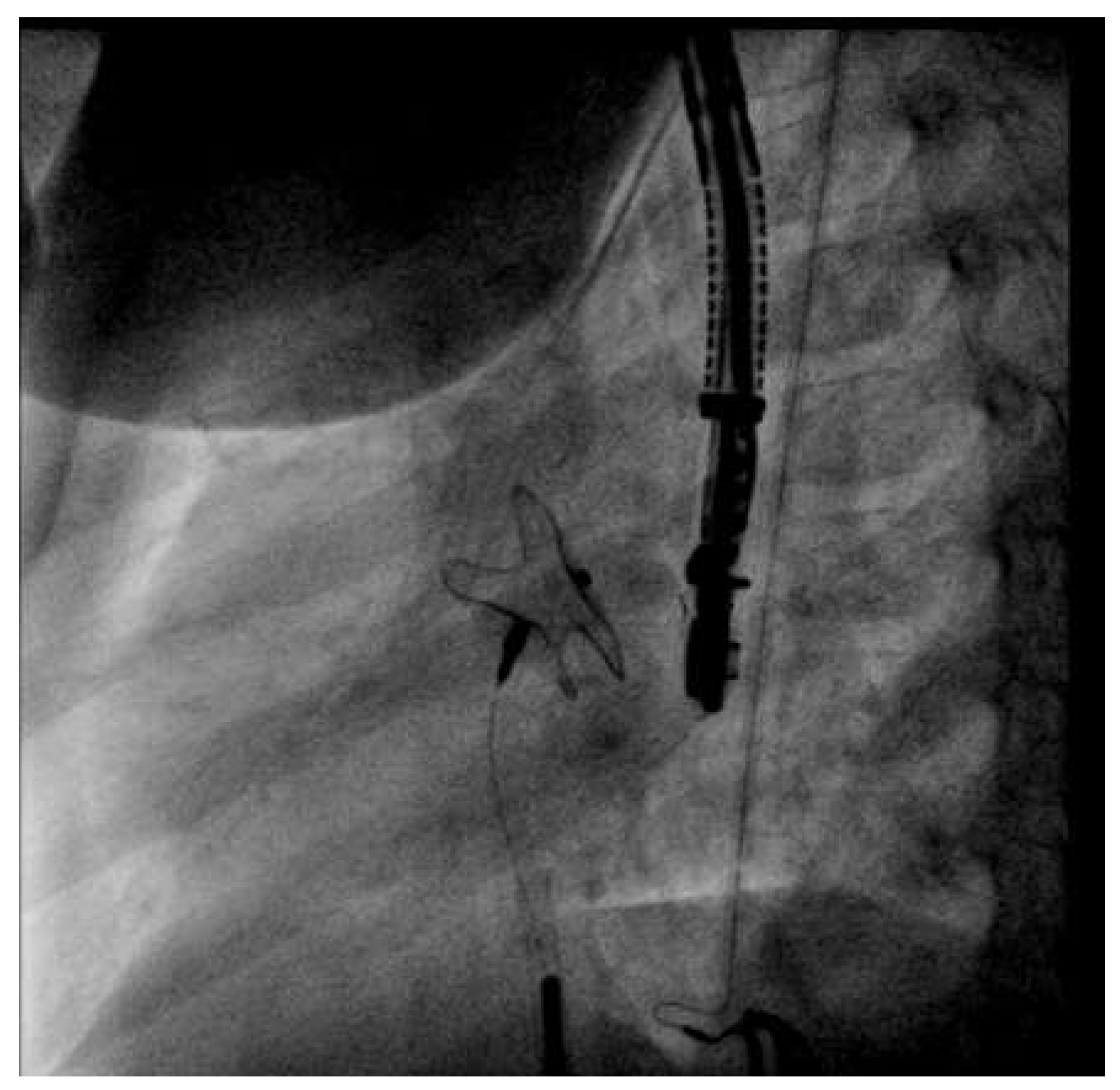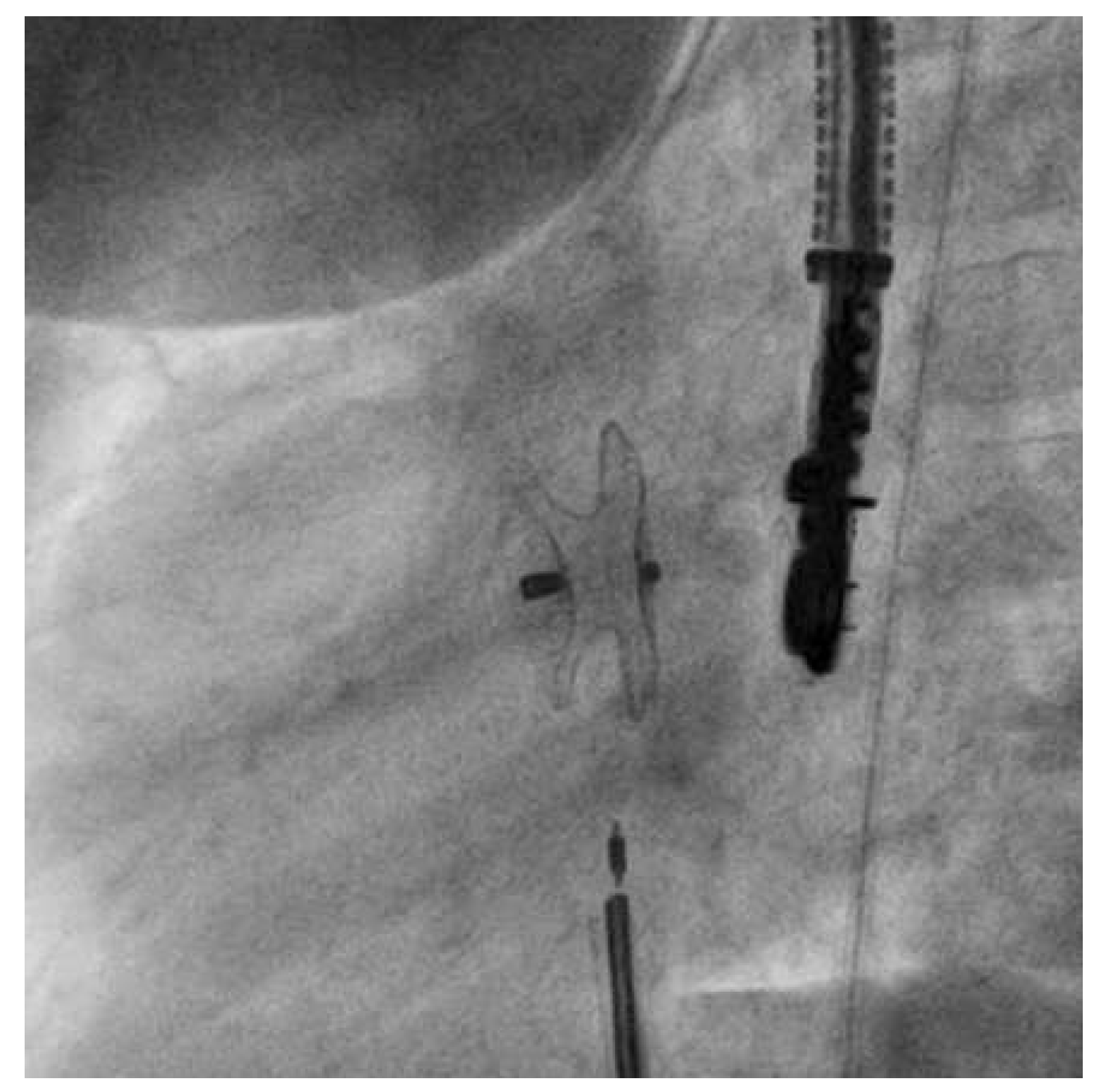Flexible Pusher Cable for Percutaneous Closure of an Atrial Septal Defect
Abstract
Introduction
Case Report
Implantation Procedure
Follow Up
Discussion
Disclosure Statement
References
- King, T.; Mills, N. Nonoperative closure of atrial septal defects. Surgery. 1974, 75, 383–8. [Google Scholar] [PubMed]
- King, T.; Thompson, S.L.; Steiner, C.; Mills, N.L. Secundum atrial septal defect: Nonoperative closure during cardiac catheterization. JAMA. 1976, 235, 2506–9. [Google Scholar] [CrossRef] [PubMed]
- Lock, J.; Cockerham, J.T.; Keane, J.F.; Finley, J.P.; Wakely P.E., Jr.; Fellows, K.E. Transcatheter umbrella closure of congenital heart defects. Circulation. 1987, 75, 593–9. [Google Scholar] [CrossRef] [PubMed]
- Roymanee, S.; Promphan, W.; Tonklang, N.; Wongwaitaweewong, K. Comparison of the Occlutech ® Figulla ® Septal Occluder and Amplatzer ® Septal Occluder for atrial septal defect device closure. Pediatr Cardiol. 2015, 36, 935–41. [Google Scholar] [CrossRef] [PubMed]
- Akagi, T. Current concept of transcatheter closure of atrial septal defect in adults. J Cardiol. 2015, 65, 17–25. [Google Scholar] [CrossRef] [PubMed]
- Bissessor, N. Current perspectives in percutaneous atrial septal defect closure devices. Medical Devices: Evidence and Research 2015, 8, 297–303. [Google Scholar] [CrossRef] [PubMed]
- Chessa, M.; Carminati, M.; Butera, G.; Bini, R.M.; Drago, M.; Rosti, L.; et al. Early and late complications associated with transcatheter occlusion of secundum atrial defect. J Am Coll Cardiol. 2002, 39, 1061–5. [Google Scholar] [CrossRef] [PubMed]
- Goel, P.; Kapoor, A.; Batra, A.; Khanna, R. Transcatheter retrieval of embolized Amplatzer septal occluder. Tex Heart Inst J. 2012, 39, 653–6. [Google Scholar] [PubMed]
- Meier, B. Catheter-based atrial shunt occlusion, when the going gets even tougher: editorial comment to use of a straight, side-hole (SSH), delivery sheath for improved delivery of Amplatzer ASD occluder. Cathet Cardiovasc Interv. 2007, 69, 21–2. [Google Scholar] [CrossRef] [PubMed]
- Freixa, X. The Amplatzer™ Cardiac Plug 2 for leh atrial appendage occlusion: novel features and first-in-man experience. EuroInter-vention. 2013, 8, 1094–8. [Google Scholar] [CrossRef] [PubMed]


© 2016 by the author. Attribution - Non-Commercial - NoDerivatives 4.0.
Share and Cite
Pallivathukal, S.; Pfammatter, J.-P.; Meier, B. Flexible Pusher Cable for Percutaneous Closure of an Atrial Septal Defect. Cardiovasc. Med. 2016, 19, 95. https://doi.org/10.4414/cvm.2016.00398
Pallivathukal S, Pfammatter J-P, Meier B. Flexible Pusher Cable for Percutaneous Closure of an Atrial Septal Defect. Cardiovascular Medicine. 2016; 19(3):95. https://doi.org/10.4414/cvm.2016.00398
Chicago/Turabian StylePallivathukal, Sabine, Jean-Pierre Pfammatter, and Bernhard Meier. 2016. "Flexible Pusher Cable for Percutaneous Closure of an Atrial Septal Defect" Cardiovascular Medicine 19, no. 3: 95. https://doi.org/10.4414/cvm.2016.00398
APA StylePallivathukal, S., Pfammatter, J.-P., & Meier, B. (2016). Flexible Pusher Cable for Percutaneous Closure of an Atrial Septal Defect. Cardiovascular Medicine, 19(3), 95. https://doi.org/10.4414/cvm.2016.00398



